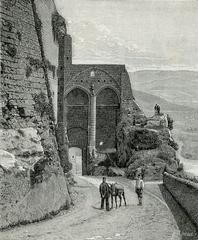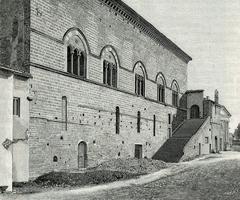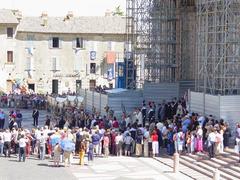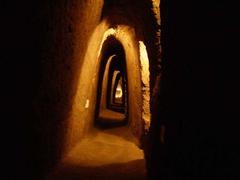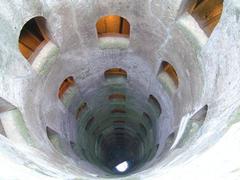Castello di San Quirico: Visiting Hours, Tickets, and Comprehensive Guide to Orvieto Historical Sites
Date: 14/06/2025
Introduction
Nestled amid the rolling volcanic plateaus of Umbria near Orvieto, Castello di San Quirico is a captivating site that embodies centuries of Italian history, culture, and natural beauty. This medieval fortress, with origins reaching back to Etruscan and feudal times, stands as a testament to the region’s architectural evolution and the power dynamics that have shaped central Italy. Today, it welcomes visitors to explore evocative ruins, scenic hiking trails, and a landscape rich in biodiversity.
Whether you’re a history enthusiast, nature lover, or cultural traveler, Castello di San Quirico and its surroundings offer a rewarding experience. This guide provides detailed information on the castle’s history, visiting hours, tickets, accessibility, travel tips, and nearby attractions, as well as insights into the environmental significance of the region. For the latest updates, consult official resources like Borgo Pirolino – Orvieto Surroundings, Orvieto Info, and Orvieto News.
Historical Overview
Etruscan and Medieval Origins
The area around Orvieto was first settled by the Etruscans, whose fortified settlements and necropolises laid the groundwork for later medieval structures. As Roman authority waned, the need for defense led to the construction of castles like San Quirico on strategic high ground, often incorporating or overlaying earlier Etruscan sites. These fortifications protected rural communities during centuries of political fragmentation.
Feudal Power and the Monaldeschi Legacy
In the Middle Ages, the Monaldeschi family rose to prominence, controlling a network of castles, including San Quirico, from the 12th century onward (Borgo Pirolino). These lords wielded both military and civic power, shaping the region’s architecture and traditions. Positioned to oversee routes between Orvieto, Bolsena, and the Alfina plateau, Castello di San Quirico was vital for regional control and economic management.
Architectural Evolution
Over time, the fortress evolved from a simple stone keep to a complex with curtain walls, towers, and a fortified gatehouse. By the 15th century, it included residential quarters, a chapel, and storage facilities. Built from local volcanic stone, its ruins today evoke the daily life and defensive concerns of medieval Umbria.
Regional Conflicts and Papal Politics
The castle played a key role during periods of conflict between feudal families and the Papal States. Its military significance waned with the consolidation of papal authority in the 16th century, but its historical aura remains, intertwined with the broader narrative of Orvieto as a center of religious and civic life (Borgo Pirolino).
Cultural and Environmental Significance
Cultural Heritage
Castello di San Quirico and its nearby borgo have long been centers of rural life and administration. The region’s traditions are still celebrated in local festivals and artisanal crafts, all set against a backdrop of restored medieval architecture (Ariella’s Villas). The castle is also a waypoint on pilgrimage and walking routes like the “Anello della Rocca” and the Orvieto Walking Marathon, connecting visitors to the rhythms of the landscape and history (Wikiloc).
Environmental Value
The Alfina plateau features rolling fields, woodlands, and traditional farms that support rich biodiversity (Orvieto News). However, intensive agriculture and monocultures have raised concerns about water quality and landscape preservation. Local groups like Comitato Quattro Strade and Italia Nostra advocate for sustainable land use and conservation (Orvietonews).
Sustainable Tourism
Responsible tourism—through hiking, cycling, and supporting local farms—helps preserve the unique environment and heritage of the region. Trails such as the Monte Tigno loop and Anello degli Etruschi offer immersive ways to appreciate the landscape while minimizing impact (Ariella’s Villas).
Visiting Castello di San Quirico: Hours, Tickets, and Practical Tips
Visiting Hours and Tickets
- Castle Grounds: The exterior and immediate surroundings are generally accessible during daylight hours; there are no fixed opening times or ticket requirements for the exterior. The interior is private and not open to the public.
- Guided Tours: Occasionally available via local operators or by special arrangement. Some events may require advance booking and a fee. Always check with the Orvieto tourist information office before your visit.
- Admission Fee: No standard entry fee for the grounds; donations for upkeep may be welcome.
Accessibility
- The castle is set on uneven rural terrain and is not wheelchair accessible. Some trails may be challenging for those with limited mobility.
- Parking is available nearby, but public transport options are limited. Car rental or taxi from Orvieto is recommended.
How to Get There
- By Car: Approximately 15–20 minutes from Orvieto, following signs to Sugano and then minor roads to the castle.
- By Public Transport: Limited; check local schedules or arrange a taxi from Orvieto.
- By Foot/Bike: Popular hiking and cycling routes from Orvieto pass near the castle (e.g., “Cammino dell’intrepido Larth”).
What to Expect
- Atmosphere: Authentic medieval ruins, panoramic views, and a tranquil rural setting.
- Facilities: No shops, eateries, or restrooms at the site. Bring water, snacks, and sun protection. Restaurants and cafés available in nearby villages and Orvieto (Traveling in Tuscany).
- Interpretation: Limited signage—consider a guidebook or local guide for context.
Photography and Drone Use
The castle and plateau are ideal for landscape and architectural photography, especially during early morning or sunset. Drone use must comply with Italian aviation regulations.
Nearby Attractions
- Orvieto Duomo and St. Patrick’s Well: Iconic attractions in the city’s historical center (Orvieto Info).
- Fanum Voltumnae: Ancient Etruscan sanctuary.
- Chiesa di Santa Lucia, Fonte del Tione: Historic and natural sites along popular hiking routes.
- Rocca Ripesena and Sugano: Other medieval castles in the area.
Responsible Tourism Tips
- Stay on marked trails and avoid disturbing ruins or wildlife.
- Practice Leave No Trace principles—carry out all waste.
- Support local farms and businesses that use sustainable practices.
- Be mindful of water conservation, as the region’s aquifers are sensitive.
- Participate in local festivals and events to connect with Umbrian culture.
Frequently Asked Questions (FAQ)
Q: Do I need tickets to visit Castello di San Quirico?
A: No standard tickets are required for the external grounds. Guided tours or events may have fees.
Q: What are the visiting hours?
A: Generally accessible during daylight hours for the exterior; interior is private.
Q: Is the site accessible for people with limited mobility?
A: The terrain is uneven and not suitable for wheelchairs.
Q: Are there guided tours?
A: Occasionally available through local operators or by arrangement.
Q: What is the best way to reach the castle?
A: By car or on foot via hiking trails from Orvieto.
Conclusion
Castello di San Quirico is a multifaceted gem, offering a journey through history, culture, and the unique landscapes of Umbria. While the fortress itself stands as a testament to the region’s medieval past, the surrounding plateau and hiking routes invite visitors to engage with nature and local traditions. Plan ahead, travel responsibly, and immerse yourself in the charm of Orvieto’s countryside.
For more up-to-date information, trail maps, and event schedules, visit official resources and consider downloading the Audiala app for guided tours and offline access.
Sources
- Borgo Pirolino – Orvieto Surroundings
- Ariella’s Villas – Castello di Pieve San Quirico
- CAI Perugia – Suganoroccaripesenasquirico
- Orvieto Info
- Orvieto News – Environmental Concerns on Altopiano dell’Alfina
- Vivo Umbria – Industrial Archaeology in Orvieto Area
- Traveling in Tuscany – Orvieto Travel Guide
- Earth Trekkers – Best Things to Do in Orvieto
- Salt in Our Hair – Orvieto Travel Information
- Orvietoviva – Castles Around Orvieto
- Italia Nostra – Local Conservation Efforts
